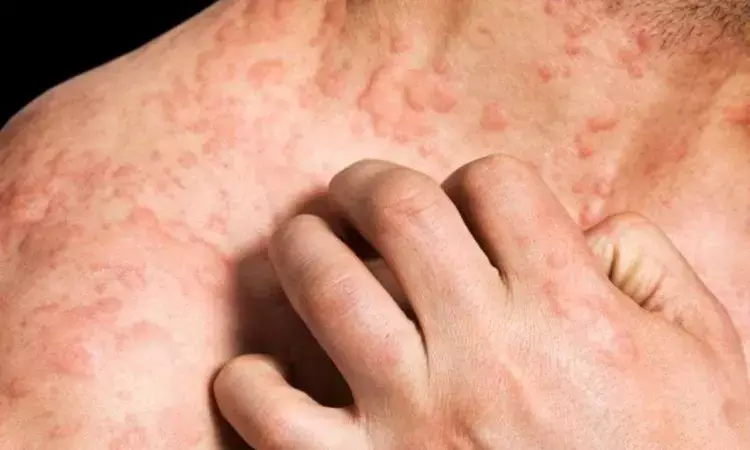- Home
- Medical news & Guidelines
- Anesthesiology
- Cardiology and CTVS
- Critical Care
- Dentistry
- Dermatology
- Diabetes and Endocrinology
- ENT
- Gastroenterology
- Medicine
- Nephrology
- Neurology
- Obstretics-Gynaecology
- Oncology
- Ophthalmology
- Orthopaedics
- Pediatrics-Neonatology
- Psychiatry
- Pulmonology
- Radiology
- Surgery
- Urology
- Laboratory Medicine
- Diet
- Nursing
- Paramedical
- Physiotherapy
- Health news
- Fact Check
- Bone Health Fact Check
- Brain Health Fact Check
- Cancer Related Fact Check
- Child Care Fact Check
- Dental and oral health fact check
- Diabetes and metabolic health fact check
- Diet and Nutrition Fact Check
- Eye and ENT Care Fact Check
- Fitness fact check
- Gut health fact check
- Heart health fact check
- Kidney health fact check
- Medical education fact check
- Men's health fact check
- Respiratory fact check
- Skin and hair care fact check
- Vaccine and Immunization fact check
- Women's health fact check
- AYUSH
- State News
- Andaman and Nicobar Islands
- Andhra Pradesh
- Arunachal Pradesh
- Assam
- Bihar
- Chandigarh
- Chattisgarh
- Dadra and Nagar Haveli
- Daman and Diu
- Delhi
- Goa
- Gujarat
- Haryana
- Himachal Pradesh
- Jammu & Kashmir
- Jharkhand
- Karnataka
- Kerala
- Ladakh
- Lakshadweep
- Madhya Pradesh
- Maharashtra
- Manipur
- Meghalaya
- Mizoram
- Nagaland
- Odisha
- Puducherry
- Punjab
- Rajasthan
- Sikkim
- Tamil Nadu
- Telangana
- Tripura
- Uttar Pradesh
- Uttrakhand
- West Bengal
- Medical Education
- Industry
NB-UVB Phototherapy Effective Alternative to Cyclosporine for Refractory CSU: Study

A new clinical study suggests that narrow Band Ultraviolet B (NB-UVB) phototherapy is effective, well-tolerated treatment for antihistamine-refractory chronic spontaneous urticaria, offering a viable alternative to oral cyclosporine.
CSU, marked by persistent hives and itching lasting more than 6 weeks, often leaves patients and clinicians struggling to find effective treatment beyond antihistamines. Cyclosporine, though effective, is typically reserved as a third-line option due to concerns about toxicity and rebound flares. The current study highlights NB-UVB phototherapy as a promising contender in this treatment landscape.
This trial enrolled 50 patients whose CSU had failed to respond to maximum-dose antihistamines. The participants were divided into 2 groups: one received NB-UVB phototherapy 3-times weekly, while the other was prescribed cyclosporine at 3 mg/kg/day. Both regimens lasted 90 days, with outcomes tracked for another 90 days post-treatment.
This study assessed patients primarily using the Urticaria Activity Score over 7 days (UAS7). Secondary measures included the Urticaria Control Test (UCT), the Chronic Urticaria Quality of Life (CU-QoL) questionnaire, and changes in serum biomarkers such as IL-6, IL-31, and IgE.
Both treatment groups showed significant symptom relief by Day 15. Cyclosporine worked faster, providing rapid reductions in UAS7, but patients frequently experienced rebound flares after discontinuation. NB-UVB, on the other hand, produced more gradual but longer-lasting control, with sustained improvements noted even after therapy ended.
When comparing efficacy, NB-UVB met the non-inferiority criteria, meaning it was not significantly less effective than cyclosporine in reducing UAS7 scores. Quality of life measures (CU-QoL) improved in both groups, while UCT scores confirmed patients reported better control of their condition under either regimen.
In terms of biomarkers, both groups experienced reductions in serum IgE. However, the cyclosporine group showed a more pronounced decrease in inflammatory markers IL-6 and IL-31, aligning with the drug’s systemic immunosuppressive effect. NB-UVB proved to be well tolerated with minimal side effects, reinforcing its suitability for long-term disease management. Cyclosporine, although effective, carried its usual risks, and the flare-ups post-discontinuation raised concerns about dependency.
The limitations of this study include its single-center design and relatively short follow-up of 90 days after treatment cessation. Broader, multi-center research with extended monitoring will be essential to validate these findings. Overall, the results place NB-UVB phototherapy firmly on the map as a potential alternative to cyclosporine in antihistamine-refractory CSU.
Source:
Roshini, N., Mehta, H., Bishnoi, A., Kumar, V., Kumar, A., Parsad, D., & Kumaran, M. S. (2025). Narrow band ultraviolet B phototherapy versus oral cyclosporine in the treatment of chronic urticaria. Photodermatology, Photoimmunology & Photomedicine, 41(5),. https://doi.org/10.1111/phpp.70050
Neuroscience Masters graduate
Jacinthlyn Sylvia, a Neuroscience Master's graduate from Chennai has worked extensively in deciphering the neurobiology of cognition and motor control in aging. She also has spread-out exposure to Neurosurgery from her Bachelor’s. She is currently involved in active Neuro-Oncology research. She is an upcoming neuroscientist with a fiery passion for writing. Her news cover at Medical Dialogues feature recent discoveries and updates from the healthcare and biomedical research fields. She can be reached at editorial@medicaldialogues.in
Dr Kamal Kant Kohli-MBBS, DTCD- a chest specialist with more than 30 years of practice and a flair for writing clinical articles, Dr Kamal Kant Kohli joined Medical Dialogues as a Chief Editor of Medical News. Besides writing articles, as an editor, he proofreads and verifies all the medical content published on Medical Dialogues including those coming from journals, studies,medical conferences,guidelines etc. Email: drkohli@medicaldialogues.in. Contact no. 011-43720751


